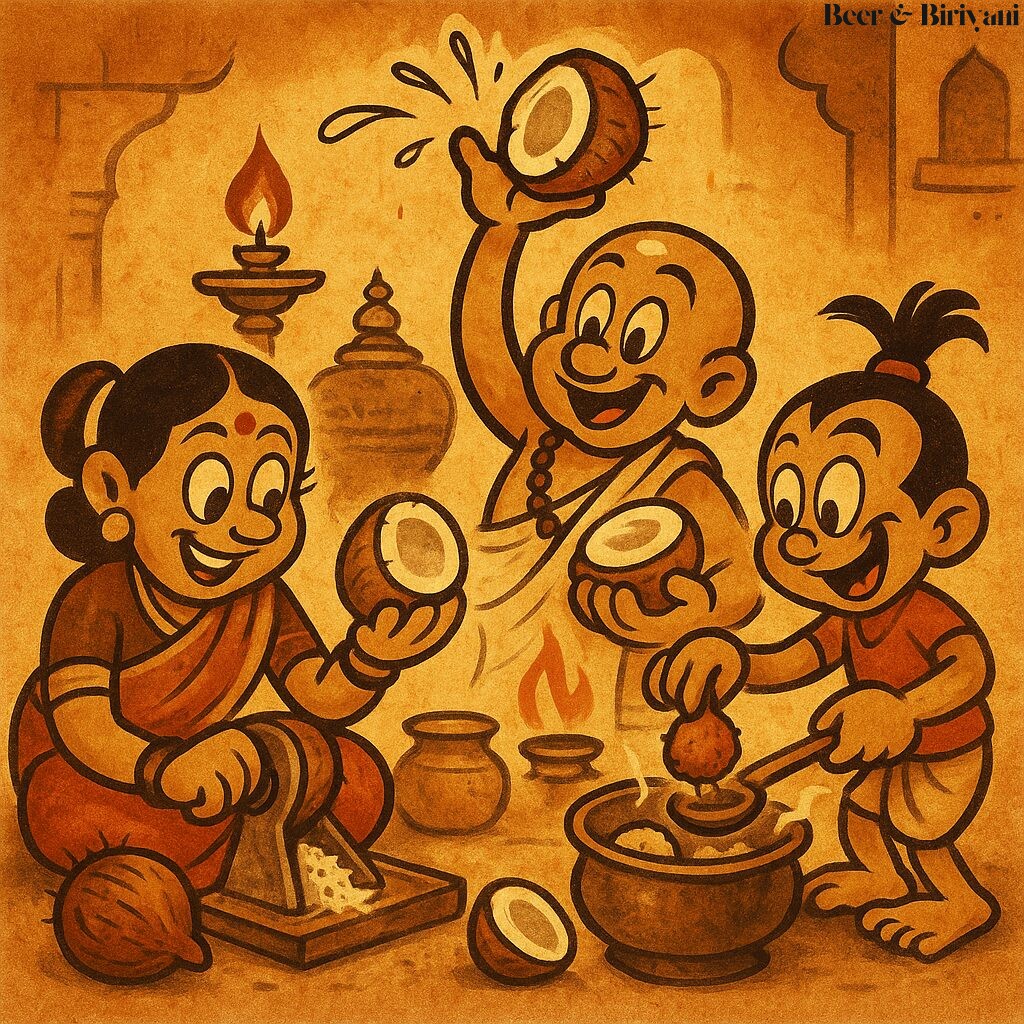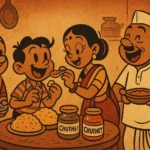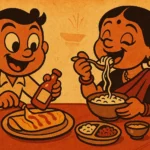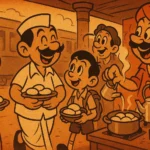In my mother’s kitchen, coconut wasn’t an ingredient. It was a given. A default. It didn’t need an introduction or a label. It just… appeared. In the chutney, in the oil, in the sweets, in the garnishing, sometimes even in the silence between meals. Grated, scraped, fried, pressed, or offered whole with a red tilak, the coconut was always there—like an old family friend who quietly knew too much but never made it a point.
If India had to elect one ingredient as its culinary and cultural multitasker, the coconut might be the clear winner. It’s edible, drinkable, spreadable, sacred, and stubborn. And it has had an emotional tenure in Indian homes that predates cold-pressed fads and tropical smoothie bowls by several centuries.
Kitchen First, Everything Else Follows
The earliest coconut memory I have is of the terrifying, rhythmic sound of the arnachatti (coconut scraper) in our Mumbai kitchen. My grandmother, hunched over, would rotate half a coconut on the blade with machine-like precision. The bowl below would fill up with soft, snowy shreds. No weighing, no measuring. Just instinct. And soon, a thoran or a modak or a thick white chutney would emerge—always simple, always satisfying.
In South India, of course, coconut is non-negotiable. From avial to payasam, it forms the structural foundation of taste. In Kerala, it’s the holy trinity of coconut oil, coconut milk, and grated coconut that defines a dish’s dialect. In coastal Maharashtra and Goa, you’ll find it tucked into fish curries, wrapped in rice cakes, and cooked down with jaggery in a laddu. Even in Bengal, the humble narkel turns elegant in sweets like narkel naru and savory shorshe chingri.
Oil as Identity
The smell of coconut oil warming in a pan is not just a culinary moment—it’s a memory trigger. That slightly nutty, rich aroma signals something nostalgic. Something from a simpler, oilier past. It’s what my hair smelled like every Sunday morning growing up, after a thorough, reluctant maalish followed by a shampoo I hoped would erase the evidence before school Monday.
Today, of course, coconut oil is on every health blog, slathered on toast and sold in minimalist glass jars. But in Indian households, it’s always been a quiet staple—used for frying, moisturizing, anointing, blessing. From scalp to spoon to sanctuary, it has long understood its role: be useful, be healing, don’t ask for attention.
Holy in a Way Ghee Never Had to Be
While ghee gets love and PR, coconut is the one invited to every ritual. It’s broken before housewarmings, weddings, business ventures, and pujas. It’s placed in kalash pots, offered in temples, and—crucially—used in funerary rites. The coconut’s role in Indian ritual is deeply symbolic. It’s seen as a representation of the human ego: hard-shelled, hairy, needing to be cracked open before offering. It’s offered whole, undivided, because it’s pure and complete by design.
Even in death, the coconut doesn’t disappear. During shraddha ceremonies and final rites, coconut is offered as a food of transition—a carrier of peace and release. It’s one of the few ingredients that moves with us from life’s celebrations to its sorrows, adapting with grace to each setting.
Global Coconut, Local Heart
When I moved to Austin, I tried using frozen shredded coconut from the Indian store. It worked, technically. But I missed the resistance of the fresh shell, the chore of scraping, the weird satisfaction of extracting every last strand. There’s a rhythm to working with coconut that no food processor can replicate. It makes you slow down. It reminds you that flavor, like meaning, often hides in texture and effort.
And then there’s the water. The moment you pierce a coconut and sip its sweet water, you’re not just drinking hydration. You’re tasting lightness. Ceremony. A reset. In many traditional fasts, coconut water is the only thing consumed all day. Because it’s gentle. Generous. Just like the nut it comes from.
The Versatile Quiet Genius
There’s something about coconut that stays with you. Maybe because it’s one of the few things that’s truly used whole. There’s no waste. No excess. The shell becomes ladles. The husk becomes fiber. The water becomes drink. The meat becomes food. It doesn’t just nourish—it participates.
And perhaps that’s why it feels sacred. Because in a country that reveres the interconnectedness of life and nature, the coconut stands as a reminder that utility and beauty can go hand in hand. That nourishment isn’t just about flavor—but about presence, tradition, and the soft crack that follows a firm strike.
So whether it’s in your chutney, your hair, your prasad, or your pantry, give it up for coconut. The quiet constant. The multi-hyphenate. The sacred sphere. It deserves it.
Born in Mumbai, now stir-frying feelings in Texas. Writes about food, memory, and the messy magic in between — mostly to stay hungry, sometimes just to stay sane.












